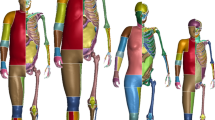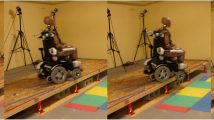Abstract
Pedestrians who use wheelchairs (seated pedestrians) report higher mortality rates than standing pedestrians in vehicle-to-pedestrian collisions but the cause of this mortality is poorly understood. This study investigated the cause of seated pedestrian serious injuries (AIS 3+) and the effect of various pre-collision variables using finite element (FE) simulations. An ultralight manual wheelchair model was developed and tested to meet ISO standards. The GHBMC 50th percentile male simplified occupant model and EuroNCAP family car (FCR) and sports utility vehicle (SUV) were used to simulate vehicle collisions. A full factorial design of experiments (n = 54) was run to explore the effect of pedestrian position relative to the vehicle bumper, pedestrian arm posture, and pedestrian orientation angle relative to the vehicle. The largest average injury risks were at the head (FCR: 0.48 SUV: 0.79) and brain (FCR: 0.42 SUV: 0.50). The abdomen (FCR: 0.20 SUV: 0.21), neck (FCR: 0.08 SUV: 0.14), and pelvis (FCR: 0.02 SUV: 0.02) reported smaller risks. 50/54 impacts reported no thorax injury risk, but 3 SUV impacts reported risks ≥ 0.99. Arm (gait) posture and pedestrian orientation angle had larger effects on most injury risks. The most dangerous arm posture examined was when the hand was off the wheelchair handrail after wheel propulsion and the two more dangerous orientations were when the pedestrian faced 90° and 110° away from the vehicle. Pedestrian position relative to the vehicle bumper played little role in injury outcomes. The findings of this study may inform future seated pedestrian safety testing procedures to narrow down the most concerning impact scenarios and design impact tests around them.







Similar content being viewed by others
Abbreviations
- AIS:
-
Abbreviated Injury Scale
- BrIC:
-
Brain injury criteria
- CAD:
-
Computer aided drawing
- DOE:
-
Design of experiments
- FCR:
-
Family car/roadster
- FE:
-
Finite element
- GHBMC:
-
Global Human Body Models Consortium
- HIC:
-
Head injury criteria
- HIT:
-
Head impact time
- ISO:
-
International standards organization
- M50-OS:
-
Male 50th percentile simplified occupant
- Nij:
-
Neck injury criteria
- PMHS:
-
Postmortem human surrogate
- SUV:
-
Sports utility vehicle
References
Boninger, M., A. Souza, R. Cooper, A. Fitzgerald, A. Koontz, and B. Fay. Propulsion patterns and pushrim biomechanics in manual wheelchair propulsion. Arch. Phys. Med. Rehabil.. 83:718–723, 2002.
Chan, Y. Biostatistics 104: correlational analysis. Singapore Med. J. 44:614–619, 2003.
Chen H., L. Fu and H. Zheng. A comparative study between China and IHRA for the vehicle-pedestrian impact. SAE Int. J. Passenger Cars Mech. Syst. 2: 1108–1115, 2009.
Chen H., D. Poulard, J. Crandall and M. Panzer. Pedestrian response with different initial positions during impact with a mid-sized sedan. In: Proceedings of the 24th International Technical Conference on the Enhanced Safety of Vehicles. Gothenburg, Sweden, 2015.
Cooper, R., M. Boninger, and A. Rentschler. Evaluation of selected ultralight manual wheelchairs using ANSI/RESNA standards. Archiv. Phys. Med. Rehabil. 80:462–467, 1999.
Cooper, R., R. Cooper, and M. Boninger. Trends and issues in wheelchair technologies. Assist. Technol. 20:61–72, 2008.
Eppinger R., E. Sun, F. Bandak, M. Haffner, N. Khaewpong, M. Maltese, S. Kuppa, T. Nguyen, E. Takhounts, R. Tannous, A. Zhang and R. Saul. Development of Improved Injury Criteria for the Assessment of Advanced Automotive Restraint Systems—II, edited by N. H. T. S. Administration, 1999.
Eppinger R., E. Sun, S. Kuppa and R. Saul. Supplement: Development of Improved Injury Criteria for the Assessment of Advanced Automotive Restraint Systems—II, edited by D. o. T. N. H. T. S. Administration, 2000.
EURONCAP. Pedestrian Testing Protocol v8.5. https://cdn.euroncap.com/media/41769/euro-ncap-pedestrian-testing-protocol-v85.201811091256001913.pdf: Euro NCAP, 2019.
Fredriksson, R., J. Shin, and C. Untaroiu. Potential of pedestrian protection systems—a parameter study using finite element models of pedestrian dummy and generic passenger vehicles. Traffic Inj. Prev. 12:398–411, 2011.
Grab-CAD. Grab-CAD: TI Lite ZRA Frame Update 1. 2022.
Grindle D., A. Balubaid and C. Untaroiu. Investigation of traffic accidents involving seated pedestrians using a finite element simulation-based approach. Comput. Methods. Biomech. Biomed. Eng. 1–14, 2022.
Grindle D., W. Pak, B. Guyleyupoglu, B. Koya, S. Gayzik, E. Song and C. Untaroiu. A detailed finite element model of a mid-sized male for the investigation of traffic pedestrian accidents. Proc. Inst. Mech. Eng. H 2020.
Klug, C., F. Feist, M. Raffler, W. Sinz, P. Petit, J. Ellway and M. van Ratingen. Development of a procedure to compare kinematics of human body models for pedestrian simulations. In: IRCOBI. Antwerp, Belgium, 2017.
Kraemer, J., and C. Benton. Disparities in road crash mortality among pedestrians using wheelchairs in the USA: results of a capture–recapture analysis. BMJ Open.5:e008396, 2015.
Kuppa, S. Injury Criteria for Side Impact Dummies, edited by N. H. T. S. Administration, 2004.
Kwarciak, A., S. Sisto, M. Yarossi, R. Price, E. Komaroff, and M. Boninger. Redefining the manual wheelchair stroke cycle: identification and impact of nonpropulsive pushrim contact. Arch. Phys. Med. Rehabil. 90:20–26, 2009.
Liu, H., R. Cooper, J. Pearlman, R. Cooper, and S. Connor. Evaluation of titanium ultralight manual wheelchairs using ANSI/RESNA standards. J. Rehabil. Res. Dev. 45:1251–1267, 2008.
MatWeb. Material property data. Automation Creations Inc., 2021.
Meyer, F., J. Humm, N. Yoganandan, A. Leszczynski, N. Bourdet, C. Deck, and R. Willinger. Development of a detailed human neck finite element model and injury risk curves under lateral impact. J. Mech. Behav. Biomed. Mater.116:104318, 2021.
Mizuno Y. Summary of IHRA pedestrian safety WG activities (2005) proposed test methods to evaluate pedestrian protection afforded by passenger cars. In: Proceedings of 19th International Technical Conference on the Enhanced Safety of Vehicles. Washington, DC, 2005.
Organization I. S. Wheelchairs. In: Part 8: Requirements and Test Methods for Static, Impact and Fatigue Strengths, 1998.
Pak W., D. Grindle and C. Untaroiu. The influence of gait stance and vehicle type on pedestrian kinematics and injury risk. J. Biomech. Eng. 143, 2021.
Pak, W., Y. Meng, J. Schap, B. Koya, S.F. Gayzik, and C.D. Untaroiu. Finite element model of a high-stature male pedestrian for simulating car-to-pedestrian collisions. Int. J. Automot. Technol. 20:445–453, 2019. https://doi.org/10.1007/s12239-019-0042-7.
Pak, W., Y. Meng, J. Schap, B. Koya, S.F. Gayzik, and C.D. Untaroiu. Development and validation of a finite element model of a small female pedestrian. Comput. Methods Biomech. Biomed. Eng. 23(16):1336–1346, 2020. https://doi.org/10.1080/10255842.2020.1801652.
Sahandifar, P., C. Makoundou, M. Fahlstedt, C. Sangiorgi, K. Johansson, V. Wallqvist, and S. Kleiven. A rubberized impact absorbing pavement can reduce the head injury risk in vulnerable road users: a bicycle and a pedestrian accident case study. Traffic Inj. Prev. 23:315–320, 2022.
Schwartz, D., B. Guleyupoglu, B. Koya, J. Stitzel, and S. Gayzik. Development of a computationally efficient full human body finite element model. Traffic Inj. Prev. 16(Suppl 1):S49-56, 2015.
Singh H., V. Ganesan, J. Davies, M. Paramasuwom and L. Gradischnig. Vehicle Interior and Restraints Modeling Development of Full Vehicle Finite Element Model Including Vehicle Interior and Occupant Restraints Systems for Occupant Safety Analysis Using THOR Dummies, edited by U. S. D. o. T. N. H. T. S. Administration, 2018.
Steinmetz, E. Americans with Disabilities:2002. Washington, DC: U.S. Census Bureau, 2006.
Takhounts, E., M. Craig, K. Moorhouse, J. McFadden, and V. Hasija. Development of brain injury criteria (Br IC). Stapp Car Crash J. 57:243–266, 2013.
Toolbox. The Engineering Toolbox. In: Friction—Friction Coefficients and Calculator, 2021.
Untaroiu C.D., W. Pak, Y. Meng, J. Schap, B. Koya, and S.F. Gayzik. A finite element model of a midsize male for simulating pedestrian accidents. J. Biomech. Eng. 140(1):011003, 2018. https://doi.org/10.1115/1.4037854.
van Beek, A., and T. U. Delft. Advanced Engineering Design: Lifetime Performance and Reliability. Delft: TU Delft, 2006.
Viano, D., I. Lau, C. Asbury, A. King, and P. Begeman. Biomechanics of the human chest, abdomen, and pelvis in lateral impact. Accid. Anal. Prev. 21:553–574, 1989.
Zheng, X., Y. Qi, H. Zhou, H. Kang, Y. Tong, and L. Bi. Bone mineral density at the distal femur and proximal tibia and related factors during the first year of spinal cord injury. Int. J. Gen. Med. 14:1121–1129, 2021.
Acknowledgments
We thank the Global Human Body Models Consortium, LLC (GHBMC) for providing their M50-OS model used in this study. All findings and views reported in this manuscript are based on the opinions of the authors and do not necessarily represent the consensus or view of the GHBMC. We would also like to thank the Advanced Research Computing organization at Virginia Tech for providing us event logs from their research computing cluster.
Author information
Authors and Affiliations
Corresponding author
Additional information
Associate Editor Stefan M. Duma oversaw the review of this article.
Publisher's Note
Springer Nature remains neutral with regard to jurisdictional claims in published maps and institutional affiliations.
Appendix
Appendix
See Fig. 8 and Tables 3, 4, 5, 6.
Rights and permissions
Springer Nature or its licensor (e.g. a society or other partner) holds exclusive rights to this article under a publishing agreement with the author(s) or other rightsholder(s); author self-archiving of the accepted manuscript version of this article is solely governed by the terms of such publishing agreement and applicable law.
About this article
Cite this article
Grindle, D., Untaroiu, C. Computational Seated Pedestrian Impact Design of Experiments with Ultralight Wheelchair. Ann Biomed Eng 51, 1523–1534 (2023). https://doi.org/10.1007/s10439-023-03157-6
Received:
Accepted:
Published:
Issue Date:
DOI: https://doi.org/10.1007/s10439-023-03157-6





